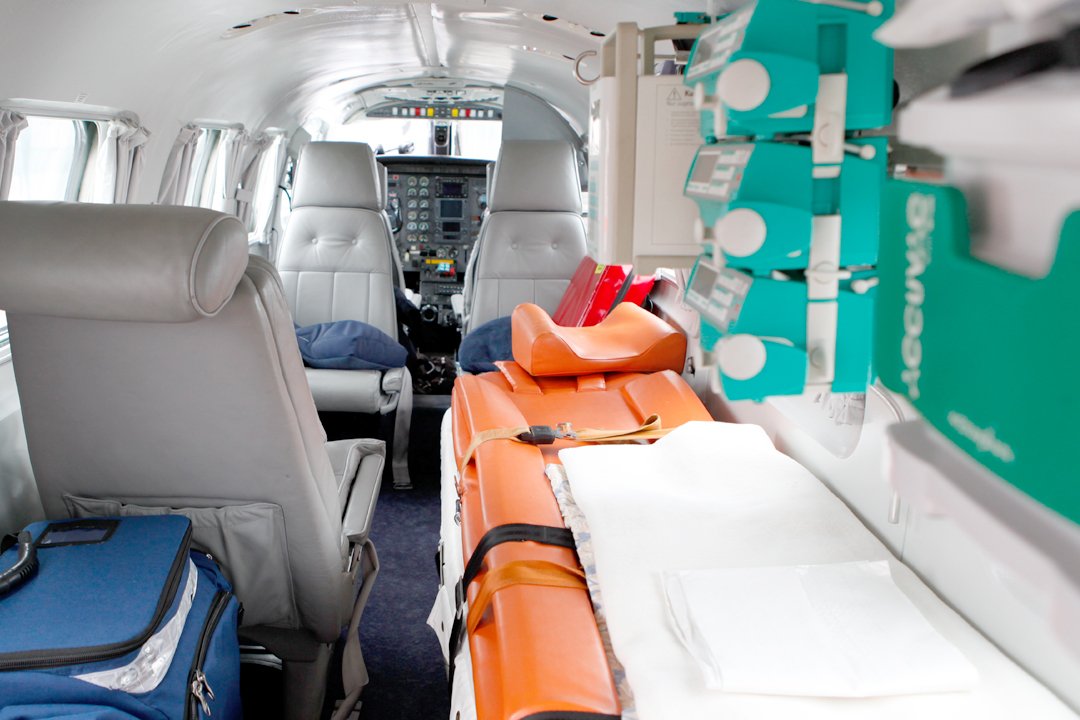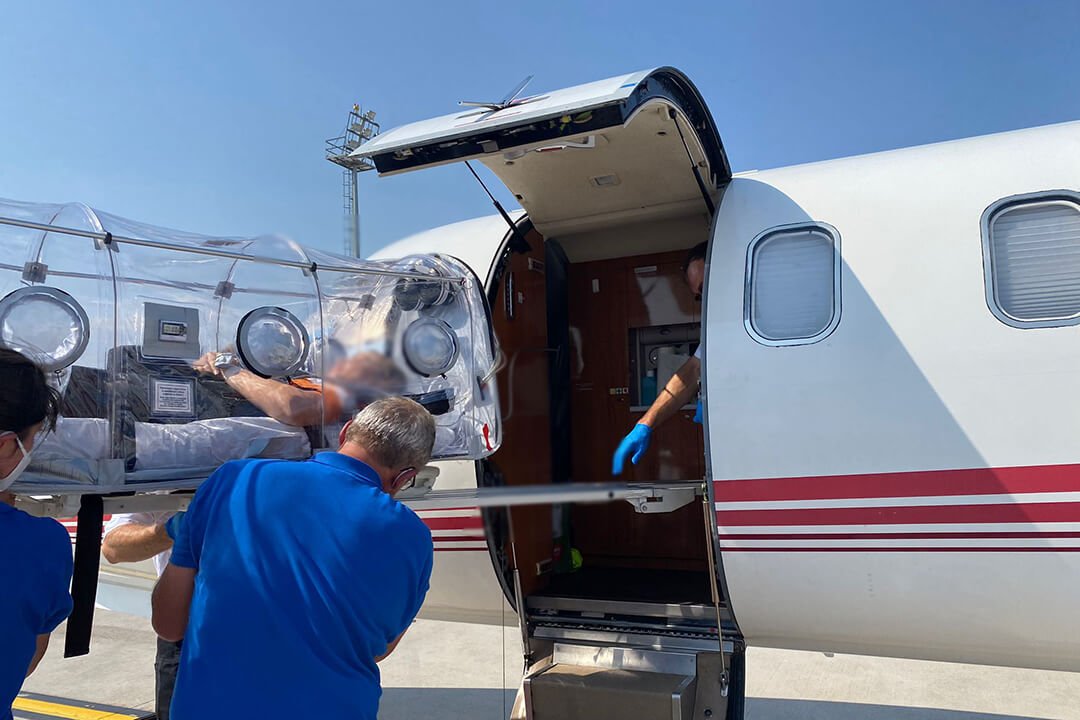Reading Time: 5 minutes
Table of contents
- The history of medical flights
- The evolution of medical flights
- Our ICU medical jets, with on-board medical experts
- Specialised paediatric ICU medical flight care
- Coronavirus critical care medical flights
- The use and importance of ICU equipment on-board medical flights
- Do you have any further questions?
- Contact us
Catastrophe can strike at any moment! Unexpected complications can be added to an already stressful situation if a critical illness or injury occurs during your trip abroad. The most pressing concern after receiving immediate medical attention is how to return home to a friendly environment and, above all, without compromising your health. Medical Air Service can bring peace of mind to this kind of situation by handling your safe aeromedical transfer. Our bed-to-bed services also provide safe and comprehensive transportation between health care facilities, allowing you to return to your home country and be with your loved ones while you recover. How do we ensure the safety of your transportation? What kind of technology do our private jets have? Before we answer these questions, let's take a look back at the history of ambulance flights.
The history of medical flights
How would you have liked to be transported to the nearest health care facility by a hot air balloon? This may appear surreal, but the first recorded air ambulance flights took place in hot air balloons in 1870, according to history. This mode of transportation was used to transfer wounded soldiers from the battlefield to hospitals during the Siege of Paris. Since then, the concept of medical assistance via air travel has become ingrained in our habits.
Even though air ambulances became more common in the 1920s (but still in a military context), it is easy to imagine that medical flights at the time were perilous. During wartime, helicopters were widely used for patient transfer, and aside from strapping patients to stretchers, little to no care was provided during transport. The desire to increase patients' life expectancy and to be able to provide appropriate care during their transfer by ambulance flight gave rise to modern EMS.
This concept inspired the development of civilian paramedics and civilian air ambulances, the use of which was initially limited to medical evacuation in Australia's rugged outback or remote, mountainous regions of Scandinavia, where travel by boat was too long and travel by land was too inconceivable. Air ambulance services have grown from these humble beginnings. People all over the world now have access to medical services and transportation that were previously unavailable.
The evolution of medical flights
Today, air ambulances come in a variety of configurations depending on the services they must provide. Medical Air Service operates and maintains cutting-edge medical planes and helicopters, as well as private jets such as the Bombardier Challenger 650 or the Bombardier Learjet 35. For the purposes of this article, let's concentrate on our private medical jets!
Our private medical jets are outfitted for the utmost comfort and safety of our patients, in addition to being maintained before and after each operation, thus exceeding the industry's safety requirements. Equipped with the most advanced avionics, they can fly patients to their destinations faster and at higher altitudes, avoiding weather conditions found at lower altitudes. The inverse is also true. In this regard, our expertise enables us to adjust the cabin pressure, which is especially important for patients suffering from pathologies such as pneumothorax or even brain tumors. Furthermore, our jets are equipped as an ICU in the sky, complete with the most advanced medical and monitoring devices.
Medical Air Service, which provides domestic and international transportation, can help almost any type of patients, regardless of their medical condition. Each of our medical flights involves two experienced medical personnel.
Did you know that? Our 24-hour service also extends to non-emergency medical patients.
Our ICU medical jets, with on-board medical experts
One of the many ways Medical Air Service distinguishes itself as an air medical transport company is that there is almost no type of medical emergency for which we cannot provide assistance. Our planes are fully equipped with cutting-edge medical technology, allowing us to provide the same level of care as an intensive care unit. From orthopaedic injuries and trauma accidents to strokes and heart attacks, our highly trained and experienced medical staff is equipped to handle the most advanced levels of medical care during your medical repatriation.
With a view to achieving the highest level of comfort, innovation and safety, our jet aircraft are configured as hospital emergency rooms, complete with medications, custom stretchers and specialised equipment. In terms of medical equipment, there are almost no limitations to patient care on-board our private medical jets, which allows even critical patients to be transported over long distances, or advances in medical equipment like the Extra Corporeal Membrane Oxygenation (ECMO).

Did you know that? In addition to being equipped to provide lifesaving care all over the world, Medical Air Service's jets offer higher patient comfort through faster air speed and longer flight range.
Each fully customised jet ambulance is outfitted with the latest technology in monitoring capability and medical devices, putting it at the forefront of the air medical industry. Some of them are:
- Defibrillator;
- Power Inverter;
- Cardiac Monitor;
- Pulse Oximeters;
- Respiratory Adjuncts;
- Intravenous Solutions;
- Airway Control Devices;
- End-Tidal C02 Detectors;
- Medical Oxygen and Suction Systems;
- Non-Invasive Blood Pressure Monitors;
- Cardiac and Emergency Medications Portable Ventilator.
Medical Air Service can staff and outfit each flight to meet your specific medical needs.
Specialised paediatric ICU medical flight care
When premature or newly born babies must travel by air to a medical facility for specialised care, no detail is too small and no precaution is too great. This is why we outfit our planes with cutting-edge paediatric incubators and isolettes to ensure that their specific medical needs are met and that they receive continuous medical treatment throughout the flight. And because we tailor our personnel specifically for every flight, we have a team of pediatric intensive care specialists on stand-by to attend to the critical care needs of our little patients. Furthermore, our flight coordinators are prepared to ensure that all medical protocols are strictly followed and that every aspect of the process is meticulously monitored.
Coronavirus critical care medical flights
While Covid-19 halted international travel, borders are gradually reopening, implying that people are beginning to travel again. And when people travel, illnesses and accidents occur, and risks of infections increase significantly. Transporting Covid-19-infected patients (who are barred from boarding commercial flights) over longer distances also increases the likelihood that their condition may deteriorate, without mentioning the possibility that they may infect other passengers as well. All of this implies that the air ambulance must carry more equipment.
Before and after each flight, all of Medical Air Service's private jets are meticulously maintained, fully equipped, and thoroughly sanitised. As long as the patients are fit to fly, the medical facilities on board allow for the transport and continuous ventilation of intubated patients. Our cabins are also outfitted with special isolation devices for passengers who are highly contagious.

The use and importance of ICU equipment on-board medical flights
Every minute counts for critically ill or injured patients who must be transported from one location to another to receive a higher level of care or specialty treatment. Transporting them in the quickest and safest manner can, in fact, make the difference between a full recovery and physical deficits or even death.
From the patient's perspective, having access to the medical equipment worthy of the most modern intensive care units allows them to travel with peace of mind. Indeed, retaining our services allows you to return to your home country, where communication with medical staff is easier, where your health history is recorded and accessible in your medical file, but also where the health system may be of higher quality, much less expensive, and sometimes even totally free.
Aeromedical transport has evolved into a critical component of global medicine practice. The development of reliable portable medical equipment allows Medical Air Service to transport injured and ill patients while continuing to provide critical care. From a doctor's point of view, having state-of-the-art medical equipment on board a medical repatriation flight is crucial to mitigating possible after-effects and even saving lives. Like land ambulances, our medical professionals provide the necessary care to stabilise your condition and avoid complications. This may involve stopping a haemorrhage, providing oxygen or simply administering medication. They are also there to provide you with the necessary psychological support.
In all cases, our intensive care equipment increases your chances of returning home in a stable condition!
Do you have any further questions?
If you were unable to pinpoint what you were looking for, please visit our FAQ page.
Contact us
Our communications centre is open 24 hours a day, seven days a week, and our private jets are available to fly at any time of day or night. Please contact us for more information on medical repatriation, air medical escorts, or to schedule an air ambulance flight right away.
Get in touch now